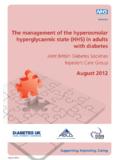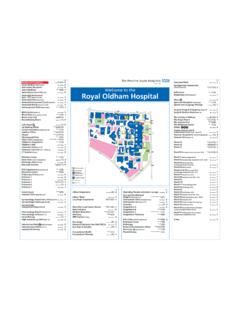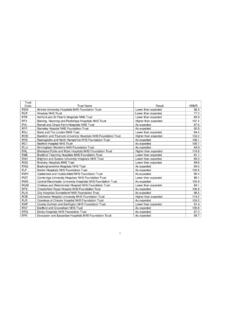Transcription of The management of the hyperosmolar hyperglycaemic state ...
1 The management of the hyperosmolarhyperglycaemic state (HHS) in adultswith diabetesJoint British Diabetes Societies Inpatient Care Group August 2012 Supporting, Improving, CaringAugust 2012 This document is coded JBDS 06 in the series of JBDS documents:Other JBDS documents:Glycaemic management during the inpatient enteral feeding of stroke patients with diabetes JBDS 05 Self- management of Diabetes in hospital March 2012 JBDS 04 The management of Adults with Diabetes undergoing Surgery and Elective Procedures: improvingstandards April 2011 JBDS 03 The hospital management of DKA in Adults March 2010 JBDS 02 The hospital management of Hypoglycaemia in Adults with Diabetes Mellitus March 2010 JBDS 01 All of these publications can be found on the NHS Diabetes website at of authors6 Executive summary 8 Introduction10 Definition and diagnosis11 Initial assessment of fluid volume status12 Clinical12 Biochemical12 Changes in mental performance during HHS13 Treatment of HHS14 Treatment goals14 General treatment principles and
2 Controversial areas15 Point of care testing15 Calculation of Osmolality15 High-dependency / level 2 care15 Type of fluid16 Osmolality, sodium and glucose16 Isotonic versus hypotonic fluid replacement16 Water replacement and hypotonic fluid17 Insulin dose and timing17 Potassium 18 Anti-infective therapy18 Anticoagulation18 Other electrolyte imbalances and complications associated with HHS19 Foot protection19 Recovery phase19 References20 FIGURE 1: Fluid balance in HHS23 FIGURE 2: Change in osmolality during treatment of HHS24 HHS care pathway25 Appendix 1: Rationale for measurement and calculation of osmolality/osmolarity31 InsertSummary HHS management guideline35 ForewordUnlike the other common diabetes emergency, diabetic ketoacidosis (DKA), guidelines on themanagement of the hyperglycaemic hyperosmolar state (HHS) in adults are uncommon and often there islittle to differentiate them from the management of DKA.
3 However, HHS isdifferent and treatmentrequires a different approach. The person with HHS is often elderly, frequently with multiple co-morbidities but always very sick. Even when specific hospital guidelines are available, adherence to and use of these is variable amongst theadmitting teams. In many hospitals these patients are managed by non-specialist teams, and it is notuncommon for the most junior member, who is least likely to be aware of the hospital guidance, to begiven responsibility for the initial management of this complex and challenging condition.
4 Diabetesspecialist teams are rarely involved at an early stage and sometimes never at address these issues the Joint British Diabetes Societies (JBDS) for inpatient care, supported by NHSD iabetes, has produced up-to-date guidance developed by a multidisciplinary group of practicing specialists,with considerable experience in this area. Where possible, the guidance is evidence based but also draws fromaccumulated professional experience. A number of new recommendations have been introduced, includingthe use of serial calculations of serum osmolality to monitor response to treatment to avoid over-rapidcorrections of the biochemical derangements.
5 These rapid shifts in osmolality have been implicated in theoften-fatal neurological complications such as central pontine myelinosis and cerebral oedema. For similarreasons we advocate that initial treatment is with sodium chloride solution alone, and that insulin is onlyintroduced when the rate of fall of glucose has plateaued. The first 24 hours or so of treatment are very labour intensive and we strongly suggest that this is undertakeneither in a medical intensive care unit or monitored bed in a well-staffed acute admissions , we propose that adherence to the guideline should be audited after every admission with HHS.
6 In conjunction with the Association of British Clinical Diabetologists (ABCD) we hope to undertake aprospective audit of the outcomes of care of people admitted with HHS to hospitals in the Adrian ScottChair of HHS writing groupAugust 20126 List of AuthorsLead authorshipDr Adrian Scott, Sheffield Teaching Hospitals NHS Foundation TrustAnne Claydon, Barts Health nhs trust Supporting organisationsTracy Kelly, Diabetes UKProfessor Mike Sampson (Norwich), Joint British Diabetes Societies (JBDS) Inpatient Care Group ChairEsther Walden (Norwich), Diabetes Inpatient Specialist Nurse (DISN) UK Group Chair Dr Chris Walton (Hull), Association of British Clinical Diabetologists (ABCD)
7 ChairWriting groupDr Geraldine Brennan, NHS TaysideDr Peter Carey, City Hospitals Sunderland NHS Foundation TrustDr Ketan Dhatariya, Norfolk and Norwich University hospital NHS Foundation TrustDr Maggie Hammersley, Oxford University Hospitals NHS TrustDr Philippa Hanson, Barts Health NHS TrustDr Stuart Ritchie, NHS LothianDr Mark Savage, The pennine acute Hospitals NHS TrustProfessor Alan Sinclair, Luton & Dunstable hospital NHS Foundation trust and Dean of Beds and HertsPostgraduate Medical SchoolJBDS IP Review GroupDr Belinda Allan, Hull and East Yorkshire hospital NHS TrustDr Daniel Flanagan, Plymouth Hospitals NHS TrustDr Maggie Hammersley, Oxford University Hospitals NHS TrustDr Rowan Hillson, MBE, National Clinical Director for DiabetesJune James, University Hospitals of Leicester NHS TrustDr Johnny McKnight, NHS LothianDr Rif Malik, King s College hospital NHS Foundation TrustDr Gerry Rayman.
8 The Ipswich Hospitals NHS TrustDr Kate Richie, Southern Health and Social Care trust , Northern IrelandDr Aled Roberts, Cardiff and Vale University NHS TrustProfessor Mike Sampson (Norwich), Joint British Diabetes Societies (JBDS) Inpatient Care Group ChairDr Mark Savage, The pennine acute Hospitals nhs trust Debbie Stanisstreet, East and North Hertfordshire NHS TrustDr Louise Stuart, The pennine acute Hospitals NHS TrustEsther Walden, Norfolk and Norwich University hospital NHS Foundation TrustDr Chris Walton, Hull and East Yorkshire hospital NHS TrustDr Peter Winocour.
9 East and North Hertfordshire NHS Trust7 Thanks also to comments from Dr Carl Waldmann on behalf of the Faculty of Intensive Care MedicineProfessional Standards Committee and Dr Steve Ball, Senior Lecturer Newcastle University & NewcastleHospitals NHS TrustWith special thanks to Christine Jones (DISN UK Group administrator, Norwich) for her administrative workand help with these guidelines and with JBDS IP8 Executive SummaryThe hyperglycaemic hyperosmolar state (HHS) is a medical emergency. HHS is different from diabeticketoacidosis (DKA) and treatment requires a different approach.
10 Although typically occurring in the elderly,HHS is presenting in ever younger adults and teenagers, often as the initial presentation of type 2 diabetesmellitus (T2DM). It has a higher mortality than DKA and may be complicated by vascular complicationssuch as myocardial infarction, stroke or peripheral arterial thrombosis. Seizures, cerebral oedema andcentral pontine myelinolysis (CPM) are uncommon but well-described complications of HHS. There is someevidence that rapid changes in osmolality during treatment may be the precipitant of CPM.






![Midlands [1 of 2] - hee.nhs.uk](/cache/preview/6/c/1/4/2/e/2/7/thumb-6c142e2790d053a442bd8a3e81c79697.jpg)
